(un résumé en français se trouve en bas de page)
[ Last update: 02.24.2014 ]
The (new)
Cadillac Database©
Cadillac and La Salle Insignia
Fisher coach logos and
emblems
Fisher Body Craftsman's Guild
Go back to the Cadillac insignia
index page
or return to the "Miscellaneous Cadillac Stuff" index
page
Return to The (New) Cadillac Database© Index Page
![]()
(un résumé en français se trouve en bas de page)
Fisher adopted a Napoleonic coach as its emblem on 10 July 1923, symbolizing the ultimate in hand built craftsmanship. The design is a combination of two French coaches; one was used at Napoleon's coronation ceremony, the other at his wedding to Marie Louise of Habsburg-Lorraine, Arch-Duchess of Austria (1791-1847)1. The latter was one in a long train of coaches that had escorted Marie-Louise from Austria to France for her wedding to Napoleon in 1810. It was used again in 1811 to convey her son, the new King of Rome (1811-1832), to his christening.
_______________________________________________________
1 Her marriage lasted just 4 years. Marie-Louise left Paris in 1814, became Duchess of Parma in 1815 and wed successively Count Neipperg and the Count of Bombelles
Historic Napoleonic Coaches
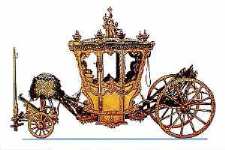
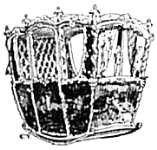
Some typical Napoleonic coach designs of the period
A scale model of Marie-Louise's coach can be seen in House Beautiful, October 1929, p.372 ( below)
Miniature Napoleonic coach drawn by team of six
The Fisher Logo
The Fisher coach logo is featured in many items of factory literature including the 1928 color catalog Nature's Studios (rear cover). Articles about it have been written in AHR [Automotive History Review] #34, Spring 1999 [excellent!], Automobile Quarterly [AQ], Vol. 25, #2, 1987, AQ Vol. 29, #4, 1991, Old Cars Weekly [OCW], 22.8.1991 (p.8), Special Interest Automobiles [SIA] #45, May-June 1978, SIA #61, 2/81, Cadillac La-Salle Club Self Starter magazine [CLC] 4/96, pp.12-14.
This plaque was correctly identified in Feb., 2008, by enthusiast Steven C. Lang who wrote: this plaque was not an award in the true sense; it was a plaque given to all the employees at Fisher Body in Warren Michigan, on the 75th Fisher Body Anniversity Celebration at the Warren Tech Site, at 12 mile and Van Dyke, in Warren, MI. I still have mine in a box and I still work at the General Motors Tech Center in Warren. Even though the 'Days of Fisherbody' is over, the memory of those day are still alive. Some people still have the logo posted in their cubes to this day. The plaques are laser etched (high tech at that time) for the graphics and very detailed. This weekend I went to a 'Model Train Show' and a retired Fisher Body/GM employee had a cast belt buckle with the same coach in detail and quality as that on the above plaque (if you want a photo of that I could send you one to put with this grouping of photos). Sure Steven, send it along! |
Fisher Body Craftsman's Guild
I saw the Fisher Body Craftsman's Guild mentioned for the first time in a 1930 La Salle product bulletin entitled "The La Salle Demonstrator". It said: "If there are boys in your home, 12 to 19 years of age (inclusive) they will be interested in enrolling in the Fisher Body Craftsman's Guild. Details of the Guild's contest, offering most desirable awards, are available on request at all Cadillac-La Salle dealers".
The Guild was a way for the company to identify and recruit young men with exceptional skill in the “crafts” needed to design and build bodies for automobiles. Recruitment was by means of magazine ads, flyers, brochures as well as by teams of recruiters who sometimes visited as many as 1200 high schools in one season. Each participant had to build a replica of the Napoleonic coach, symbol of Fisher Body, based on a scale model completed by the Fisher craftsmen themselves.
Blueprints for the first model were non-existent and had to be drawn up. Frank Riess, former head of the industrial arts department of a Detroit high school, created the master plans (a copy may still be seen in the Fisher Body Craftsman's Guild Foundation (FBCGF) collection in Eagle Point, OR - in that collection also are some of the winning coaches as well as other Guild memorabilia).
Walter Leuschner of Germany, a skilled coach-builder in the Fisher plant at Fleetwood, PA, built two prototype coaches from these plans; these were around 1/15 to 1/18 scale (in which 1 inch = approx. 1' 3" to 1' 6"); one of the master coach models is featured in a Saturday Evening Post advertisement for April 2, 1932. Some less-elaborate and detailed blueprints and an instruction guide were drawn up for the competitors. Many of the details were left to interpretation. It was more than just an assembly process. A great deal of creativity in design and materials was required for a competitive entry. It was not unusual for a youngster to spend well over a thousand hours on a model.
Basic kits were available to all competitors. They came in a box about 10x10x30 inches. In it were stock pieces of pine, mahogany and other types of wood. There were also rough aluminum parts needing to be finished, including the ornate roof railings and "eagle" corner posts. Brass strips were provided and served to make suspension spring leaves. Wheel spokes and rims had to be made up from scratch. Included in addition to detailed assembly instructions were swatches of leather and cloth as well as small bottles of DuPont "Duco" paint, solvents and paint brushes. The finished model measured 18" long (28" including the tongue), 11" tall and 9" wide; it weighed around 7 pounds. Suspension and steering both were functional as were the door handles and latches as well as the folding steps for ease of entry and egress; the doors incorporated sliding glass windows. The cloth and leather samples supplied were used to upholster the interior, which featured cushioned seats, headliner, door panels and carpeting.
Almost 1,500 boys competed in the first edition; the best of them (104 in all, from 48 states and the District of Columbia) were convened in the fall of 1931 to a prize-winning ceremony held in the auditorium of the GM building in Detroit [source: Time magazine, Aug. 31, 1931]. There were two categories: "Junior" (ages 12 to 15) and "Senior" (ages 16 to 19); each entrant hoped to win one of four GM scholarships, each worth $5,000, in addition to the $50 pocket-money they had got to spend on the trip to Detroit.
The judges who examined the entries and selected the winners were President Thomas Stockham Baker of the Carnegie Institute of Technology, Board Chairman Robert Andrews Millikan of California Institute of Technology; Board Chairman Samuel Wesley Stratton of Massachusetts Institute of Technology; Dean Dexter Simpson Kimball of Cornell's College of Engineering and eight other engineering deans and professors.
The "Senior" winners were Raymond S. Doerr of Battle Creek, and Albert Fischer from Waukegan Ill. One "Junior" winner was Howard Jennings of Denver, CO. Over the years the competition lasted, some 245,000 American boys between the ages of 12 and 19 participated. Many of the winners later were offered and managed successful careers at Fisher Body and GM.
|
|
|
Fisher Body Craftsman's Guild Foundation
Nobody knows more about the Guild and the competition, nor has accumulated more of the surviving competition coaches than Skip Geear, who has devoted a small, private museum to this fascinating part of the history of GM and the Fisher Body Corporation. The museum is located on Skip's 20-acre spread, 9 miles north of Eagle Point, OR, 18 miles north of Medford, OR and some 40 miles north of the California border [had we known about it at the time, Gita and I certainly would have visited the museum, which is only a few miles off the route we followed through Oregon in the fall of 2006].
Among the museum holdings is one of the two prototype coaches built in the late 20s by Walter Leuschner; there are also the original set of plans drawn by Frank Riess, as well as more than two dozen surviving competition coaches. Skip's prized possession, however, is a full-scale Napoleonic coach commissioned by Fisher from the late Francis Londo who had been one of the Guild competitors in 1934. It was completed only in 1991. Londo willed it to Skip before he died.
The Londo full-sized coach weighs one and a half tons;
it measures 16 feet long and is 9 feet high
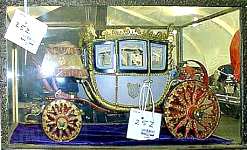
The model on the left was up for auction at Scottsdale, AZ, in January 1999
The coach on the right is a family heirloom; it was built by the grandfather of Kendra Kroll,
a Database visitor in July 2001, whom I should like to credit with this photo.
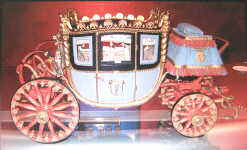
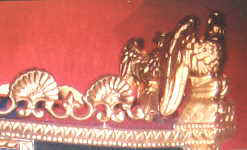
Here is another "competition" coach; look at all that incredible detail!
This prize-winning model
was constructed by the late Harold Wilkin
This is the 1934 National Senior winner;
it was built by Truman W. Cottom of Texas
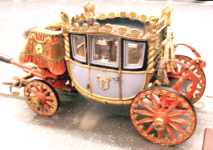
Here are two more prize-winners
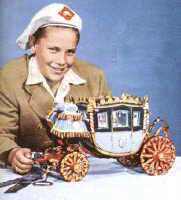
Left: 1932 competition winner, Roger Oetting; note the competition cap with the "FBCG" patch
Right: the young Guild competitor at far right, with Oetting, is none other than Virgil Exner, then aged 11;
he went on to become the driving force behind Chrysler styling
Guild History
Interestingly, the Guild continued in existence well into the sixties (the last year for the competition being 1968) and continued also to encourage American boys to build automotive scale models. In 1960, in a booklet entitled The Story of Body by Fisher, a couple of pages are devoted to the Guild. By that time it had awarded 238 university scholarships totaling over $640,000 and paid out more than one million dollars in prizes (the total purse in 1960 alone was $117,000). From 1930-1960, the Guild enrolled more than five million boys of which a half-million in 1960 alone.
|
The Silver and Gold Commemorative Coach
In 1972-73 Fisher issued a Golden Anniversary portfolio. In it was offered to all GM dealers a silver and gold commemorative scale model of the Fisher coach. The cost was $2,000 a piece. Only 1000 units were to be built, hallmarked and inscribed with the owner's personal registration number. The item was described as "what promises to be one of the most sought after collector items ever produced in a precious metal." To my knowledge, there is no official record of how many were effectively built nor who bought them. In the last 30+ years I only ever saw one offered for sale ...at a price!
Fisher Golden Anniversary
commemorative silver and gold scale model
[ as illustrated in the flyer ]
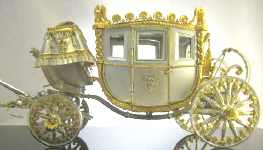
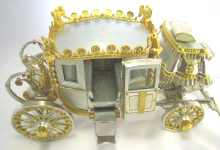
The (final?) Guild Reunion, June 2004
As Vice-President of Design, retired, Chuck instigated a meeting in late June, 2004 of winners of the Guild contest. It was staged in the massive Design Dome at the General Motors Tech Center in Warren, Michigan. Some 60 winners attended. The oldest winner was Henry Larzelere, he built a coach for the 1936 edition; the youngest was Tom Graboski who won the Styling Award at age 13 in 1968, the final year. On display in the "Dome", were all their winning entries. An awesome sight. Next day, a fund raising event for the blind was held in a large marquee, where the models were once again on display. Among the entrant's was Virgil Exner Jr. He was interviewed on that occasion by twice-President of the CLC, Ron Van Gelderen. You can read the interview in the Self Starter for June, 2005. The reunion lasted through Monday when the group visited the brand new GM Heritage Center, a few miles north of the Tech Center, where GM's car collection and extensive archives now are housed under one large roof.
Misc. Guild Stuff
I have seen a booklet published by the Guild in the sixties (?) entitled Design & Build a Model Car. It was provided to college engineering and design students as an aid to creating a professional model of a futuristic car, a part of competing for a Guild scholarship. The brochure It measures 8½ x 5" and comprises 35 pages, with many illustrations and tips. My old friend Charles "Chuck" Jordan, who was to become GM Design Chief entered and won such a competition in the fifties.
|
For more reading about the Guild, visit this Web page on the site created by Richard Earl, grandson of Harley J. Earl: http://www.carofthecentury.com. The most interesting "Fisher Coach" site on the Web is this one: http://www.geocities.com/sponcom26/CoachMuseum1.html
In researching the history of the Fisher Body Craftsman's Guild, I came across a Web site on the Internet, devoted to scale-modeling in general. Interestingly, on the site's message board, there were a number of postings that relate to the Fisher Coach competition of the mid-thirties. Here are some of the entries:
Carolyn Cottom wrote: My father, Truman Cottom, entered the competition twice. He won 4th place in 1933 and 1st place in 1934. I don't know if this was state or national. He lived in Texas at the time and won a four-year college scholarship in 1934.
George Lake wrote: My half brother Milton Lake built a coach for the contest. It has been carefully preserved and is in possession of his widow in Manitoba Canada
Linda Barrett wrote: I have the complete original plans, in excellent condition. Also have the coach that my father made for the 1932 competition, along with some associated newspaper articles, and the wooden shipping box that was constructed according to the original plans.
Lina Nilan wrote: My Father in law has a coach he was building in high school for a scholarship
A. Rasmussen wrote: My Father (Harold E. Rasmussen 1919-1991 of Milestone Saskatchewan Canada) won a scholarship at M.I T. We (my sister brother and myself believe). A ribbon in the coach's glass case says 'JUNIOR FIRST GRAND AWARD 1934 - CANADIAN SECTION'.
Finally, here's a book from 2005 by John L. Jacobus that presents the Guild from inception, through expansion and up to the end, in 1968. Many aspects of the Napoleonic coach model are covered in these 336 pp. (ISBN 0-7864-1719-6 and ISBN 9789-0-7864-1719-3) - ad in SAH Journal, issue #230, Sept.-Oct. 2007, p.9
Fake ?
|
( résumé en français)Fisher, carrossier attitré de la firme, prit pour emblème, le 10 juillet 1923, ce superbe carrosse napoléonien pour symboliser son travail artisanal soigné.
Il s'agit d'un assemblage de deux carrosses différents; le premier fut utilisé à l'occasion du couronnement de Napoléon, l'autre pour son mariage en 1810 avec Marie-Louise de Habsbourg-Lorraine, archi-duchesse d'Autriche. Ce carrosse reprit du service à l'occasion du baptême de son fils, le roi de Rome.
En 1931, la firme Fisher lança un concours pour jeunes américains âgés de 12 à 19 ans. Il y eut 245,000 participants. Le but en était d'encourager la jeunesse à se vouer à l'artisanat. Il leur fallait reproduire le plus fidèlement possible une maquette du carrosse qui avait été préparée à cet effet par la firme elle-même. Les plans en avaient été dessinés par Frank Riess, enseignant dans une éclole technique de Detroit. Deux maquettes furent réalisées d'après ces plans par Walter Leuschner, maître-artisan d'origine allemande. Le quatre premiers lauréats se virent offrir des bourses d'étude d'une valeur de $5000; une jolie somme en 1931!
La maquette d'origine réalisée par Fisher figure sur une publicité de la firme parue dans "Saturday Evening Post" le 2 avril 1932.
En 1973, pour commémorer son cinquantenaire, la firme mit en vente 1000 modèles réduits à l'échelle 1/18e, en argent et or, au prix de $2000 pièce. Ces maquettes étaient destinées aux distributeurs Cadillac dans tout le pays.
Go back to the Cadillac insignia index page
or return to the "Miscellaneous Cadillac Stuff" index page
Return to The (New) Cadillac Database© Index Page
© 1996, Yann Saunders and the Cadillac-LaSalle
Club, Inc.
[ Background image: superimposed Cadillac and La Salle emblems, 1929 ]